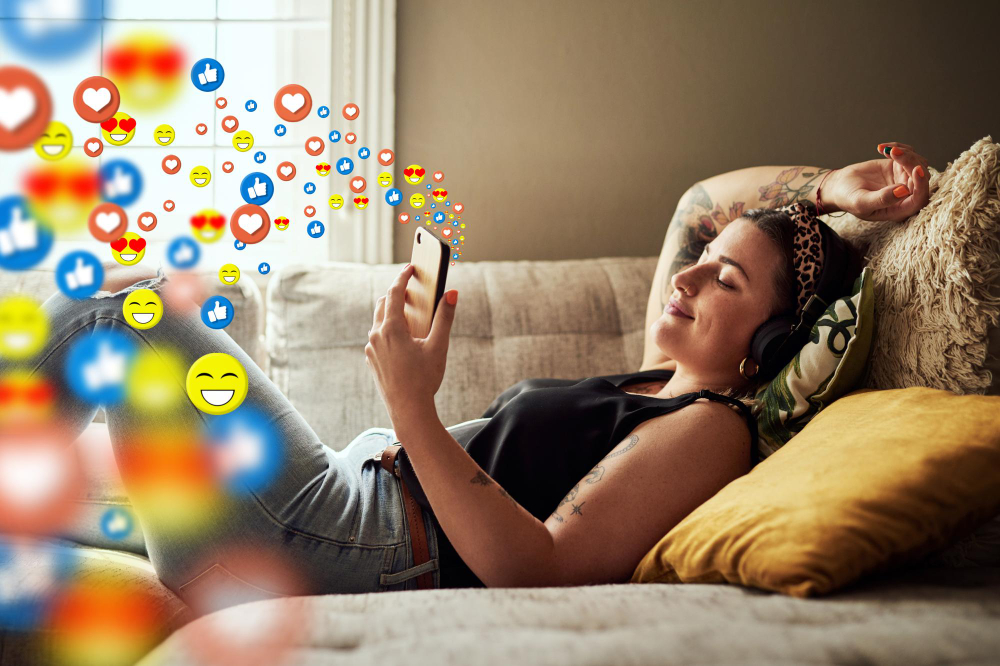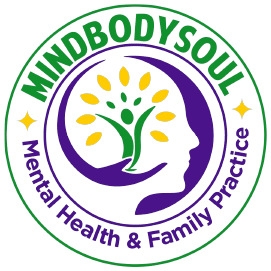6 Ways to Boost Your Mental Health Using Social Media

In a world where social media is as habitual as morning coffee, it’s pivotal to navigate these digital spaces in ways that uplift rather than undermine our mental health.
At MindBodySoul Health, we understand the complex relationship between digital consumption and mental well-being. That’s why we’ve crafted this ultimate guide to turning your social media into a sanctuary of positivity and self-care, ensuring that every scroll, like, and share contributes to your journey towards a healthier, happier you.
Page Contents
1. Curate Your Feed, Cultivate Your Mind
The power of transformation lies right at your fingertips – quite literally. By curating your social media feed, you’re essentially gardening your digital landscape, deciding which plants (or content) to nurture and which weeds (negative influences) to pull out.
This proactive approach doesn’t just change what you see daily; it fundamentally alters the nutrient soil of your mind, influencing your thoughts, feelings, and overall mental well-being.
Here’s how to become a master curator of your digital space:
- Prioritize Mental Enrichment: Just as you choose nourishing foods for your body, feed your mind with content that enriches and elevates. Seek out pages and people who share inspirational quotes, success stories, and educational material. This not only brightens your day but also expands your horizons and fosters a growth mindset.
- Diversity Is Key: Exposing yourself to a wide range of cultures, ideas, and perspectives can dramatically enhance your empathy and understanding of the world. Follow accounts from different countries, cultures, and viewpoints to diversify your feed. It’s like traveling the world without leaving your home, offering you a kaleidoscope of human experiences.
- Create a Joy Bubble: Sometimes, we all need an escape valve from the pressures of the world. Infuse your feed with accounts that are pure joy – be it cute animal videos, comedy sketches, or feel-good movies recommendations. These pockets of joy can be your go-to whenever you need a mental health boost.
- Engage with Content that Challenges You: While it’s important to maintain positivity, engaging with content that challenges your viewpoints or pushes you out of your comfort zone can be incredibly growth-inducing. Follow thought leaders and organizations that tackle important social issues or offer a different perspective on familiar topics. This helps you build resilience and a more nuanced understanding of the world.
- Beautify Your Visual Diet: Pay attention to the aesthetics of the content you consume. Beautiful imagery, whether it’s nature photography, art, or design, can have a soothing effect on the mind. It’s a gentle reminder of the world’s beauty, encouraging mindfulness and appreciation of the moment.
Remember, Your Feed Is Your Garden: Like any garden, your feed requires regular maintenance. Take time each month to review who you’re following and make adjustments as needed. This ensures that your digital space remains a source of positivity, inspiration, and growth. By consciously curating your feed, you’re not just passively consuming content; you’re actively cultivating a mindset that supports and enhances your mental health.
2. Engage Positively when Using Social Media
In the vast expanse of the digital world, the way we engage with content and communicate with others can significantly influence our mental health and the online community’s atmosphere.
Positive engagement isn’t just about avoiding negativity; it’s about actively contributing to a culture of kindness, support, and understanding.
Here’s how you can be a beacon of positivity on social media:
- Lead with Empathy: Behind every profile is a real person, navigating their own challenges and triumphs. When commenting or responding to posts, imagine speaking face to face. This perspective encourages more thoughtful, compassionate interactions, which can create ripples of positivity.
- Share Encouragement Liberally: Make it a habit to leave supportive comments or share uplifting messages. A simple “You’ve got this!” or “Thank you for sharing your story” can mean the world to someone. It’s these small gestures of kindness that often have the most significant impact.
- Celebrate Others’ Successes: Social media is a powerful platform for acknowledging and celebrating achievements. Congratulate others on their milestones, big or small. This fosters a culture of encouragement and mutual support, counteracting the envy or competitiveness that can sometimes arise online.
- Constructive Conversations: Engage in discussions with the aim of understanding and adding value. When faced with differing opinions, approach with curiosity rather than confrontation. Ask questions, share insights, and respect diverse viewpoints. This enriches your learning experience and contributes to a more open, respectful online community.
- Spread Positivity Through Content: Share content that inspires, educates, or entertains in a positive way. Whether it’s a motivational quote, an informative article, or a funny meme, your shares can be a source of light in someone’s day. Consider creating your own content that reflects your journey, insights, or joyous moments.
- Be a Part of the Solution: When encountering negativity or misinformation, use it as an opportunity to spread positivity. Offer correct information with kindness, report harassment, and support those who might be targets of online negativity. Your actions can help create a safer, more positive space for everyone.
Creating a Ripple Effect: Remember, every positive interaction on social media has the potential to create a ripple effect, encouraging others to do the same. By consciously choosing to engage positively, you’re not only enhancing your own mental well-being but also contributing to a more supportive and enriching online environment for all.
3. Set Boundaries when Using Social Media
In the endless stream of notifications, likes, and comments, it’s easy to lose track of time and even ourselves. Setting boundaries around your social media use is not just about limiting screen time; it’s about reclaiming your time, energy, and mental space.
It’s a declaration that you value your peace of mind and are taking active steps to protect it.
Here’s how you can create and maintain healthy boundaries that support your mental health:
- Mindful Notifications: Start by evaluating which notifications you truly need. Each ping or buzz can be a distraction or even a source of anxiety. Customize your notification settings to only receive alerts for what genuinely matters to you, minimizing unnecessary interruptions.
- Designate ‘Social Free’ Zones: Identify times and places where social media is off-limits. Meal times, the bedroom, and when spending quality time with loved ones are great places to start. These ‘social free’ zones can help you stay present in the moment and foster real-world connections.
- The 20-Minute Rule: Implement the 20-minute rule by limiting your social media check-ins to 20 minutes at a time. This can help prevent the all-too-common scenario of falling into a social media rabbit hole. Setting a timer can keep you accountable.
- Social Sabbaticals: Consider taking regular breaks from social media, whether it’s a day each week or a week every few months. These sabbaticals can provide a refreshing mental reset, allowing you to return to your digital spaces with a renewed perspective and energy.
- Reflect on Your Social Media Use: Regularly take time to reflect on how your social media use is affecting your mental health. Are you feeling more connected or isolated? Energized or drained? Adjust your boundaries accordingly.
- Communicate Your Boundaries: Let your friends and followers know about your social media boundaries. This not only helps set expectations but also encourages others to reflect on their own social media habits.
Setting boundaries around social media is an ongoing process that requires regular reflection and adjustment. But by taking these steps, you can ensure that your social media use is intentional, balanced, and supportive of your overall well-being.

4. Embrace Authenticity
In the age of polished feeds and curated personas, embracing authenticity on social media is a breath of fresh air. It’s about letting go of the pressure to present a perfect version of your life and instead showing up as your true self, flaws and all.
This level of authenticity can foster deeper connections, reduce feelings of isolation, and boost self-esteem by affirming that it’s okay to be imperfect.
Here’s how to embrace and promote authenticity in your digital interactions:
- Share Your Real Story: Instead of only highlighting the highs, consider sharing your challenges and setbacks. This doesn’t mean airing personal grievances but showing that, like everyone, you face obstacles. It’s about balance and honesty. Sharing your journey towards overcoming difficulties can be incredibly inspiring and relatable to others.
- Connect Over Common Interests: Use social media to express your genuine interests and passions. Whether it’s a hobby, a cause you care about, or a quirky obsession, sharing what truly excites you can attract a community of like-minded individuals. Authentic connections are formed on the foundation of shared interests and mutual understanding.
- Practice Vulnerability with Discretion: While being open can lead to meaningful connections, it’s also important to practice vulnerability with discretion. Consider the impact of what you’re sharing on both yourself and your audience. It’s about finding the right balance between being open and maintaining boundaries that protect your emotional well-being.
- Support and Celebrate Others: Authenticity isn’t just about how you present yourself; it’s also reflected in how you interact with others. Offer genuine support, celebrate others’ successes, and engage in meaningful conversations. Positive reinforcement and kindness can go a long way in creating a supportive and authentic online community.
- Stay True to Your Values: Regularly reflect on whether your social media engagement aligns with your personal values. Are you contributing positively to the digital space? Are your interactions genuine and respectful? Staying true to your values ensures that your social media presence is a true reflection of who you are.
By being real about your experiences, interests, and values, you not only enrich your own mental health but also contribute to a more authentic, supportive online community. Remember, the beauty of social media lies in its ability to connect us through our shared humanity — imperfections included.
5. Practice Mindful Scrolling
Mindful scrolling is about bringing consciousness to our digital consumption habits. It’s easy to fall into the trap of mindlessly swiping through feeds, but this can lead to overconsumption of negative content, comparison, and ultimately, a sense of dissatisfaction.
By practicing mindful scrolling, we can transform our social media use into a more intentional and fulfilling experience.
Here’s how to cultivate mindfulness in your digital interactions:
- Pause Before You Scroll: Before diving into your social media feeds, take a moment to pause. Ask yourself what you’re looking to achieve or how you want to feel during this session. Setting an intention can guide your scrolling and help you stay focused on content that aligns with your mental and emotional goals.
- Notice Your Reactions: Pay attention to how different posts make you feel. Do you feel inspired, happy, or perhaps envious and inadequate? Noticing your emotional reactions can help you identify which accounts to follow or unfollow, tailoring your feed to be a source of positivity.
- Engage Actively, Not Passively: Shift from passive consumption to active engagement. Instead of just scrolling, leave thoughtful comments, share posts that move you, and use social media to interact meaningfully with others. This shift can make your social media time feel more valuable and connected.
- Set Time Limits: Being mindful of the time you spend on social media can prevent hours of aimless scrolling. Use app timers or set specific times of the day for social media, ensuring that it doesn’t encroach on time you could spend on other fulfilling activities or rest.
- Take Regular Breaks: Every so often, put down your phone and take a break. Look around you, stretch, or engage in a quick mindfulness exercise. These breaks can refresh your mind and reduce the risk of feeling overwhelmed by digital information.
- Reflect on Your Experience: After your social media time, reflect on the experience. Did it meet your intention? How do you feel mentally and emotionally? This reflection can help you make adjustments to ensure that social media is a tool for positive engagement rather than a source of stress.
Practicing mindful scrolling is an act of self-care. It encourages us to be present with our digital interactions, ensuring they serve our well-being and keep us connected to what truly matters. By adopting these habits, we can create a more intentional and satisfying online experience that supports our mental health.
6. Discover and Learn when Using Social Media
Social media is not just a platform for connecting with others; it’s a vibrant, ever-evolving library of knowledge. From uncovering new interests to deepening understanding of long-held passions, the potential for discovery and learning is limitless.
Starting this aspect of social media can not only enrich your intellectual life but also positively impact your mental health by fostering a sense of curiosity and continuous growth.
Here’s how to leverage social media as a tool for discovery and learning:
- Follow Educational Accounts and Hashtags: Whatever your interests—be it science, history, art, or personal development—there are countless accounts dedicated to teaching and inspiring. By following these, you turn your feed into a learning hub, receiving daily doses of knowledge and inspiration.
- Participate in Webinars and Live Events: Many experts and organizations host free or low-cost webinars and live events on social media. These can be excellent opportunities to learn directly from specialists, ask questions, and engage with a community of learners.
- Join Groups Related to Your Interests: Social media groups can be goldmines for learning and sharing knowledge. Whether it’s a group dedicated to amateur astronomy, language learning, or gardening, you’ll find communities eager to share insights, advice, and resources.
- Use Social Media for Research: Beyond casual browsing, social media can be a powerful research tool. Use it to stay updated on the latest studies, trends, and discussions in your field of interest. Following relevant professionals and joining specialized forums can provide deep insights and keep you at the cutting edge of knowledge.
- Share Your Learning Journey: As you learn, don’t hesitate to share your journey with others. Posting about your discoveries, insights, and even challenges not only consolidates your learning but can also inspire and educate your network.
- Curate a Learning Playlist: Many platforms allow you to save posts, articles, and videos for later. Use this feature to create your own curated “learning playlist” that you can refer to when you have more time to dive deep into your interests.
By integrating these practices into your social media routine, you transform your digital spaces into vibrant classrooms. This not only breaks the monotony of aimless scrolling but also aligns your online activities with your personal growth and learning goals.
The joy of discovering something new, the thrill of mastering a challenging topic, and the satisfaction of engaging with fellow enthusiasts can greatly enhance your mental well-being, making social media a valuable ally in your journey of lifelong learning.
Conclusion
Harnessing social media to boost your mental health is all about intentional use. It’s choosing to engage with content and communities that feed your soul, setting boundaries that protect your peace, and using the platforms as tools for growth and connection. By implementing these strategies, you can create a social media experience that not only feels good but is good for you.




